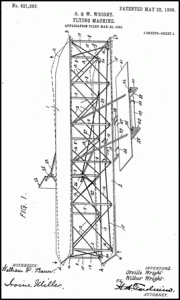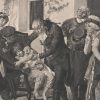Using Patents as a Genealogy Resource
Have you discovered that your ancestor was an inventor? Did you know that their patent records can provide you with some great genealogical information? Let’s take a look at how patents can be an excellent genealogy resource!
Genealogical information found in patent records include:
First and last name of the inventor
Each patent in the U.S. must contain the first and last name of the inventor or co-inventors and their address. You may be able to find a maiden name or evidence of name changes either through marriage or legal name changes. As always, keep in mind misspellings of a person’s name and search for variations of your relative’s name. Some files may contain a page at the end with error corrections; however, because it was an additional fee to make corrections, this will not be included in all patent records.
Picture of the invention and signature
You may be interested to see a picture of your relative’s invention as well as their signature. Keep in mind that in some cases their attorney may have signed on your ancestor’s behalf.
Citizenship status
Many patents may contain the citizenship status of the applicant. If your ancestor submitted several patents over time, you may note a change in citizenship. This could possible lend clues as to when your ancestor became a U.S. citizen.
Change of address
If your ancestor held several patents, take note of any address changes. Because each patent requires the current address of the inventor at the time, you may be able to track your ancestor’s movements. They may have moved within or between cities or states. You may even be able to map out a timeline of your ancestor’s movements!
Assignee
The assignee can tell you whether your ancestor transferred their legal rights to the patent to another person or organization. In many cases, the assignee is the inventor’s employer. This could possibly provide you with clues into your ancestor’s occupation and place of work.
Executors
In the case of the inventor’s death, a relative may be listed as the executor or administrator. Information here can include the relationship between the inventor and the executor (widow, child etc.), the executor’s occupation, citizenship, a list of heirs and other useful information.
How do I find patents?
In the U.S., patents are issued at the federal level with unique patent numbers. Therefore, you can easily find patents online through the U.S. Patent and Trademark Office or Google Patents. If you are looking for patents outside of the U.S., the U.S. Patent and Trademark Office also offers links to searchable databases overseas.
File Wrappers
For a fee, you can request a copy of the file wrapper. The file wrapper is a folder of all application papers for the applicant. This includes documentation between the applicant and their attorney and the patent examiner. You may even find documentation about the commercial success of the invention.
Don’t forget to add any documents you may find to your ancestor’s Geni profile to share with others! Perhaps you may want to add your ancestors to our Inventors and African American Inventors projects and become a project collaborator!








 Genealogy Discussions
Genealogy Discussions Genealogy Projects
Genealogy Projects Popular Genealogy Profiles
Popular Genealogy Profiles Surnames
Surnames The Geni Blog
The Geni Blog The World Family Tree
The World Family Tree